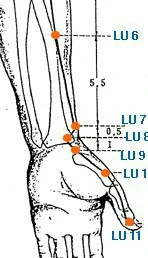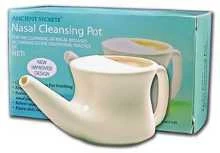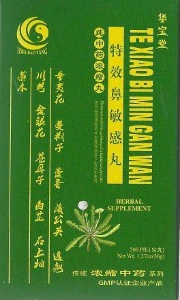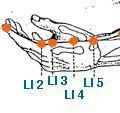Self-Help, Acupressure, and Acupuncture for Seasonal Allergy Relief
Well, it's that time again. The pollen streams are flowing, and so are your sinuses. As is the case with many acupuncturists, we see a great number of people for seasonal and year round allergies in our clinic. In fact, along with conditions such as pain, anxiety & depression, headaches & migraines, and fertility, allergies are one of the most commonly treated conditions with acupuncture and Chinese Medicine.
Within this article I am going to offer some theory to explain how acupuncture is used to treat allergies as well as offer some of the self-help recommendations that I frequently make to many of my allergy patients.
Causes of Allergies:
In basic terms, allergies arise from a hypersensitive immune system. How it got that way can be from over exposure to certain substances, from having low immunity in general, or from being around too many allergens at any given time. The bottom line is that your body has "learned" to be allergic to certain substances. Treatment involves rebalancing the immune system to stop the allergic response to various stimuli.
Chinese Medicine Theory:
From a Chinese Medicine perspective what people are allergic to is less of an issue - so allergy tests, for example, are not necessary for treatment. What does help is knowing when the allergies started. Did the allergies start when you were young? Did they start after a few stressful years in college? or perhaps after some other combination of life changes?
 Other useful information is knowing how strong the persons immune system is - do you get frequent colds and flus? do you have related conditions such as asthma, wheezing, etc.? Additionally, seemingly unrelated information (which is very related) such as stress levels, quality of sleep, and dietary issues that might contribute to allergies.
Other useful information is knowing how strong the persons immune system is - do you get frequent colds and flus? do you have related conditions such as asthma, wheezing, etc.? Additionally, seemingly unrelated information (which is very related) such as stress levels, quality of sleep, and dietary issues that might contribute to allergies.
Knowing that Chinese Medicine treats the entire person and not just a condition, all of this information is crucial for finding an appropriate diagnosis. For symptoms of allergies these can be patterns such as Lung Qi Deficiency, Kidney Qi Deficiency, Wind Cold, Wind Heat, etc. The important part of these names is that they allow you to fine tune a treatment to each person which is why acupuncture, properly applied, can be so effective for allergies.
Treatment Goals:
As opposed to western treatments which are intended simply to block the symptoms (which they do a decent job of), Chinese Medicine offers both acute treatments for symptom relief and treatments over a longer period with the goal of regulating the imbalance behind the allergies.
That is, the ultimate goal of Chinese Medicine is to completely treat the root cause of allergies within you so that the symptoms do not come back.
The best time to come for treatment is 2-3 months before the season starts. For better or for worse most people come at the peak of the season where we have to focus more on symptomatic relief before we can focus solely on the underlying causes. Either way, for the majority of people we can lessen the symptoms they have for the current season and greatly reduce if not entirely eliminate the responses in following seasons. For year round sufferers, anytime is a good time to start treatment.
What Self-Help Options Can I Use?
Dietary Change:
One of the leading contributors to allergy problems is excessive intake of dairy products, particularly milk. Dairy in Chinese Medicine contributes to the production of mucus and is an irritant to the immune system. Hard cheeses and yogurt are better tolerated, but they still should be used minimally. If you are concerned about calcium know that there are plenty of other sources such as oranges, almonds, and kale to help meet your dietary requirements.
The test I usually have people do is to drink some milk, or eat some cheese and see if their nose starts to run relatively soon afterwards. For those food items that elicit this response you should use them sparingly if at all particularly during allergy season.
Nasal Cleansing:
 Nasal cleansing (or neti) pots are an extremely useful self-help tool. Nasal cleansing is done with specially designed pots that rush a salt water mixture through your nasal passage and out of the other nostril.
Nasal cleansing (or neti) pots are an extremely useful self-help tool. Nasal cleansing is done with specially designed pots that rush a salt water mixture through your nasal passage and out of the other nostril.
The process is most effective if done daily during your peak allergy times whether or not your symptoms are aggravated. The process helps keep pollen and other irritants out of your nasal passages and the salt mixture helps to remove inflammation so you can breath easier. The vast majority of people find the neti pot and very helpful tool.
Chinese Herbal Medicine:
While obviously biased, I prefer using Traditional Chinese Medicine (TCM) herbal formulas to many of their western medical counterparts. Many of these formulas have been around for hundreds of years and play a dual role of symptomatic relief and helping to heal the underlying causes. Within TCM, there are many options and it is best to seek a consultation with your acupuncturist to find which one is most suited for you.
 A very commonly used formula is Te Xiao Bi Min Gan Pian which is very helpful for the relief of allergy symptoms and has a strong track record of safety. When people are outside of their peak allergy season we may use other formulas to strengthen their lungs and immune system more broadly to avoid future allergy problems. But for most, this is what we use for primary symptom relief and it works quite well without making people feel hazy.
A very commonly used formula is Te Xiao Bi Min Gan Pian which is very helpful for the relief of allergy symptoms and has a strong track record of safety. When people are outside of their peak allergy season we may use other formulas to strengthen their lungs and immune system more broadly to avoid future allergy problems. But for most, this is what we use for primary symptom relief and it works quite well without making people feel hazy.
Acupressure:
Another option for symptomatic relief of allergy symptoms is acupressure. A few of the most commonly used acupressure points for allergy relief are listed below:
- UB 2
- Location: On the Bladder meridian, located directly above the inner corner of the eye on the inside end of the eyebrow (you will feel a little notch in the bone there and it will be quite sore).
- Uses: Sinus congestion, red, watery eyes...
- LI 20
- Location: On the Large Intestine meridian, located on either side of your nose about 1/8 of an inch back from the tip (where your nose and your face meet).
- Uses: Any sinus issues...
- LU 7
- Location: On the Lung meridian, located about 1.5 fingers width above your wrist crease, just after the styloid process of the radius. Generally found by sliding your finger from the thumb side of your wrist crease over the styloid process and press where sore.
- Uses: cold symptoms (sneezing, chills, runny nose), sore throat.
 LI 4
LI 4
- Location: On the Large Intestine meridian, located in the middle of the web between your thumb and forefinger. Generally found by sliding your finger from the joint of your index finger towards your wrist stopping in the depression where the thumb and the index finger bones meet and pressing where most tender
- Uses: headaches in the front of the head, pain anywhere, cold symptoms such as runny nose, sneezing, etc. {{Do not use if pregnant}}.
A useful acupressure for allergies protocol would be to hold, UB 2 on both sides, then LI 20 on both sides, then LU 7 on the left side, LI 4 on the left side, then LU 7 and LI 4 on the right (avoiding LI 4 if you are pregnant). Each point should be held for 30-60 seconds and you can repeat the sequence or individual points 2-3 times a day when experiencing allergy symptoms.
Hopefully you will all find some useful tools within this presentation and can start eliminating your need to suffer through another allergy season. While western medications are very helpful they do not treat the underlying causes of allergies. By balancing our immune systems in general we can offset these issues in the future.
At their base, allergies, often involve the lung and spleen systems within Chinese Medicine, you may explore these aspects further in "My Lungs are What?" and "My Spleen is What?".
tag @yinyanghouse for questions/comments